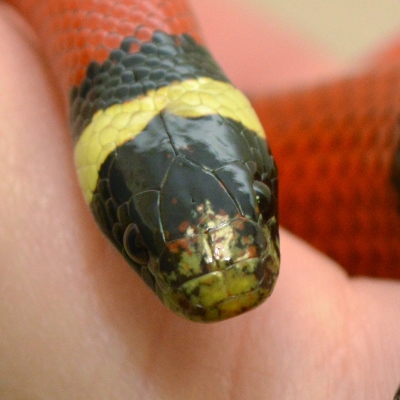
It’s the last day of the month, which means it’s the last day of our Animal of the Month for August. We hope you enjoyed our tweets about the colourful Sinaloan milk snake as you followed us on Twitter @ExoticPetVets. In case you missed any of our tweets this month, here is a summary for your reference. Did you know?:
- Milk snakes are endemic to the Americas and have a range that stretches from Canada all the way down to the northern portion of South America.
- There are about two dozen subspecies of milk snakes of which the Sinaloan milk snake (Lampropeltis triangulum sinaloae) is one.
- As the name suggests, Sinaloan milk snakes are endemic to northwestern Mexico. In the wild, they are found in just three of Mexico’s 31 states – Sinaloa, Sonora and Chihuahua.
- Why are Sinaloan milk snakes – and all the other milk snakes – called milk snakes? Do they drink milk? The answer is no.
- Milk snakes are so named from a false old belief that milk snakes would suck the milk out of cows until they were dry, which is impossible based on snake anatomy.
- It’s believed this folk legend about milk snakes started because they can be found in or near barns in areas with human populations.
- The Sinaloan milk snake is nocturnal, which means he is mostly active at night.
- In the wild, Sinaloan milksnakes are found in semi-desert environments and will typically rest during the day under rocks or cactus plants or in rock crevices.
- Sometimes Sinaloan milk snakes are found in barns or under woodpiles if they are in areas inhabited by people.
- In captivity, Sinaloan milk snakes should be provided dark hiding spaces so they can rest during the day.
- Sinaloan milk snakes defend themselves partly by using Batesian mimicry, which means they evolved to resemble another species that is poisonous.
- Sinaloan milk snakes are non-venomous, but they look strikingly similar to coral snakes who are highly venomous.
- Predators may leave a Sinaloan milk snake alone if they mistake him for a coral snake. But sometimes this backfires as humans will kill them thinking they are venomous.
- Sinaloan milk snakes are mostly red, which is broken up by colour bands of black and creamy-yellow. Coral snakes have similar colour markings.
- You can tell Sinaloan milk snakes and coral snakes apart by looking carefully at the colour pattern – Sinaloan milk snakes have red and black next to each other while coral snakes have red and yellow side-by-side.
- There are two simple rhymes to help distinguish between coral and Sinaloan milk snakes – “Red on yellow kills a fellow. Red on black, friend of Jack” or “Red on yellow kills a fellow. Red on black, venom lack.”
- In addition to the Batesian mimicry that we tweeted about on Monday, Sinaloan milk snakes also defend themselves by discharging a pungent smell from their cloaca.
- The cloaca is the common cavity for the reproductive, urinary and digestive tracts found in Sinaloan milk snakes and all snake species.
- The Sinaloan milk snake diet mostly consists of rodents. But they are opportunistic eaters and will also eat amphibians, other snakes, lizards, small birds and eggs.
- Because Sinaloan milk snakes are nocturnal, they will eat at night.
- Sinaloan milk snakes do well in captivity and are popular pet snakes. Not only are they non-venomous, but they also have a docile temperament.
- Sinaloan milk snakes are also not very big. Fully-grown, they reach an average length of about a metre (about 40 inches).
- It is unknown how long Sinaloan milk snakes live in the wild. But with good care in captivity, they can live between 12 and 20 years.

